
Deposition Date
2022-06-06
Release Date
2023-05-03
Last Version Date
2023-10-25
Entry Detail
PDB ID:
8D6J
Keywords:
Title:
Human Ago2 bound to miR122(21nt) with PIWI loop swapped to AtAgo10 sequence
Biological Source:
Source Organism:
Homo sapiens (Taxon ID: 9606)
Synthetic construct (Taxon ID: 32630)
Synthetic construct (Taxon ID: 32630)
Host Organism:
Method Details:
Experimental Method:
Resolution:
2.50 Å
R-Value Free:
0.28
R-Value Work:
0.23
R-Value Observed:
0.23
Space Group:
P 1 21 1


